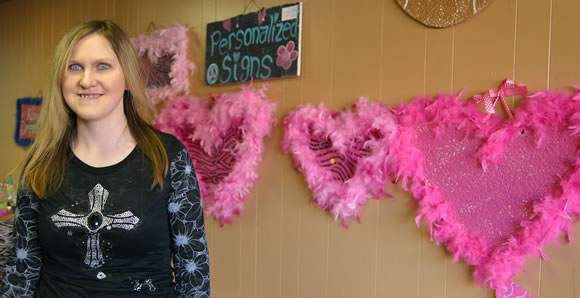
It can happen to anyone anywhere at anytime.
Everyone is vulnerable: the young, the old, the weak, and the strong.
It can strike during the day or at night.
Or in Ronna (Edwards) Newman’s case, while running track.
“I was fourteen in 1999, and it was the first day of eighth grade track practice,” Ronna said. “I don’t remember that day at all, but from what they told me, I didn’t feel good. We were supposed to run three laps, and the beginning of the third lap I collapsed and went into cardiac arrest.”
February is American Heart Month. Heart disease is the number one cause of death in women and 90 percent of women have one or more risk factors for developing the disease.
In fact, if not for fast reactions from two coaches, Ronna probably would not be here today.
“The coaches performed CPR until the ambulance got there,” Ronna said. “They had to use the external defibrillator two times, and the third time they finally got a heartbeat. They took me to Claude and then airlifted me to Amarillo where I was in the hospital for a couple of weeks.”
Ronna was diagnosed with a rare heart condition, called Arrhythmogenic Right Ventricular Dysplasia, which is known to be among the top causes of sudden cardiac death among young athletes.
“My heart rate would get over 200 beats a minute,” Ronna said. “I didn’t know it though because I was born that way, and it was just normal for me. There had been no other heart problems in my family, just high blood pressure.”
Ronna left the hospital with an internal defibrillator and an altered lifestyle.
“I can’t do anything that will get my heart rate up, so of course I couldn’t run anymore,” Ronna said. “That’s when I started playing golf. I haven’t had any problems with my heart since then.”
Ronna is not the only woman in Clarendon who has experienced a heart attack. For Melinda McAnear, president of the Donley County Hospital District, she was watering her flowers when it happened.
“I was 56 on June 23, 2006, and I had a pain in my chest,” Melinda said. “It was nothing real bad, so I blew it off for a little bit. In ten minutes it had not gone away, but it had not gotten worse. It was like nothing I had ever experienced.”
After calling her husband, Ronnie, Melinda decided to call the ambulance. She now regards this as one of the best decisions she ever made.
“The EMTs told me that I was having a heart attack, and I didn’t believe them at first,” Melinda said. “I always thought that having a heart attack would be excruciating pain, but it wasn’t. I had none of the classic symptoms of a heart attack, like radiating pain in my left arm or shortness of breath. It was just ‘uncomfortableness’ in my chest.”
Melinda remained conscious throughout the ambulance ride to BSA , where she was diagnosed with Coronary Artery Disease. She received a heart stint.
“I had never had heart problems before that, but there are cases of heart disease on both sides of my family,” she said. “Fortunately there was no heart or muscle damage. I had 90 percent blockage; and if I would’ve waited any longer, I probably would have died from a massive heart attack.”
From her heart attack, Melinda said she learned a valuable lesson.
“When you have a gut feeling that something is wrong, you need to listen to your body because it’s trying to tell you something,” Melinda said. “I listened and paid attention, and I’m sure glad I did.”
In recognition of Heart Month, Melinda wears a red dress pin, which is the symbol for women fighting heart disease.
“My cardiologist gave it to me the year after my heart attack, and I’ve worn it ever since in February,” Melinda said.
Ronna and Melinda stress the importance of heart check-ups, because neither one ever expected to have a heart attack.
“It’s a good thing to get checked up, because it can happen to anyone,” Ronna said. “You never know when it may happen.”


Leave a Reply
You must be logged in to post a comment.